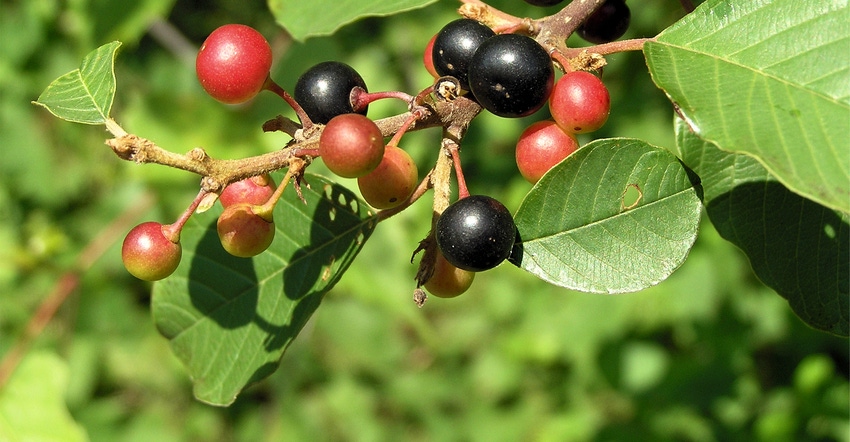
Shades of multiflora rose! There’s an attractive “spoiler” invading northern woodlots, timber, even pastures and wetlands — glossy buckthorn.
This shrub was widely recommended for conservation plantings in the Midwest until its invasive tendencies became apparent, note Michigan State University authorities. It creates dense thickets and outcompetes native vegetation. And seeds from its pea-sized berries are widely dispersed by birds and small mammals.
That’s why it’s a growing threat in public and private woodlands in all Northeast states, south to Pennsylvania and New Jersey and all the way west to the Dakotas. It is also why the University of New Hampshire has received a $500,000 USDA grant to explore managing this and other invasive plants in private forests.
Glossy buckthorn starts out as a small shrub, but grows into a small tree up to 20 feet tall, with a spreading crown. It leafs out early in the spring and retains its leaves late into fall. So now is a good time to scout for it, and develop a control plan. It’s a particular pest on soils with wet feet, but is also successful on many upland sites including old fields, roadsides and open woods.
Worth the bother
This plant is an alternate host for alfalfa mosaic virus and crown fungus, which causes oat rust disease. It’s also implicated as a possible host for soybean aphids. It also outcompetes the eastern white pine, an important forest resource in New England.
If it’s caught early in its invasion, it may be eradicated completely. But fragmented land ownership presents a challenge to controlling it. That’s why the UNH Agricultural Experiment Station is exploring the economic impact of managing invasive plants in forests owned by private landowners.
The project’s long-term goal is to determine to what extent having many private forest landowners with different ownership objectives — as is the case in the U.S. Northeast — acts as a driver of bio-invasions. Some 35% of U.S. forests are owned by more than 10 million individuals and families with different goals and motivations, points out Shadi Atallah, UNH assistant professor of environmental and resources economics. And land ownership fragmentation is expected to increase.
“These landowners' individual invasive management decisions over time and across a forested landscape can either facilitate or impede society's ability to manage invasions,” Atallah says. “Effective management of invasive plants is critical for the long-term ecological health of forest ecosystems and economic vitality of communities.”
Atallah and his research team plan to map the risk of glossy buckthorn invasion in New Hampshire, Maine and Massachusetts. They’ll also estimate the costs and benefits of available and new glossy buckthorn control strategies. Then they’ll conduct focus groups, surveys and experiments with landowners within the invasion hot spot areas to estimate their willingness to adopt the available management strategies.
About the Author(s)
You May Also Like




